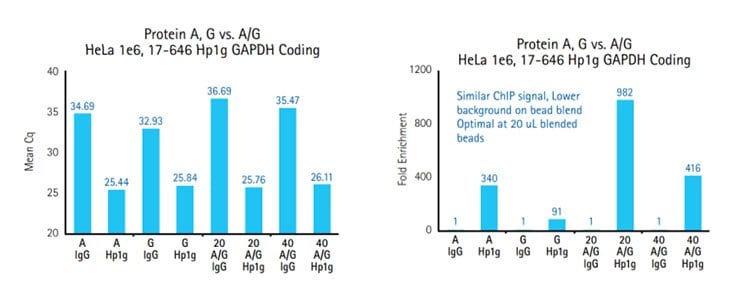Agarose Beads Vs. Magnetic Beads in ChIP
The ChIP antibody may be conjugated directly to agarose or magnetic beads or it may be immobilized on beads conjugated to protein A and/or protein G. Original ChIP protocols used agarose beads, but many long time ChIP users have moved to magnetic beads. Magnetic beads enable rapid isolation of protein/DNA complexes from the crude chromatin mixture using a magnetic separation device, such as the Magna GrIP™ Rack (20-400), Magna GrIP™ HT96 rack (17-10071).
Agarose beads perform well in the hands of many researchers and offer a less expensive, but more time consuming option. These beads require centrifugation for separation and may exhibit nonspecific binding, which may require blocking and lysate preclearing.
We offer both agarose and magnetic beads as well as ChIP kits. Our kits and beads are offered in a variety of formats including protein A, protein G, as well as a blend of protein A and G conjugates (protein A/G). The choice of bead type is often influenced by the type of antibody one plans to use for their experiment. Protein A beads exhibit the highest affinity for rabbit polyclonal antibodies, whereas the protein G beads bind a wider range of antibodies including most, but not all, classes of mouse monoclonal IgGs. The protein A/G blend provides the most flexibility in terms of the type of antibody that you can use, because it combines the binding characteristics of both protein A and protein G. Our research and development team has found that the protein A/G blend typically produces lower backgrounds than protein A or G alone, for a wide range of antibodies without compromising the efficiency of pull down (Figure 1).
Protein A/G Beads: 17-646 ChIPAb+™ Hp1g (CBX3) Protein G Purified Mouse Monoclonal

Figure 1. Comparison of ChIP using Protein A or G alone vs. A/G Blends. Consistent with lower background signal, IgG signals are detected later (higher Cq) using protein A/G bead blends as compared to protein A or G beads alone (left graph).
In addition similar Cq are detected using protein A/G bead blends as compared to protein A or G alone suggesting no loss of signal. Lower backgrounds with similar recovery of signal result in higher fold enrichments with A/G blends as shown in graph on the right.
Regardless of your choice of beads, the order in which you apply magnetic or agarose beads to your ChIP reaction may affect your ChIP signal. One method is to incubate the beads with the capture antibody (few hours at room temperature, or overnight at 4 °C) followed by addition of chromatin and further incubation (1 hour to overnight with rotation, at 4 °C). Increasing the time of incubation may increase both the background and the ChIP signal; however, antibodies with low affinities for their targets generally do not produce significant ChIP signals without longer (overnight) incubations. Alternatively some protocols incubate the antibody and chromatin and then add beads, or add all three components at the same time. Adding all three components often works, and reduces the time required to perform the overall reaction.
Magnetic Beads
Protein A/G Beads
Effective bead capture: Polyethylene rack contains 4 neodymium magnets
Versatile: Rack may also be used with either 15 mL or 0.5 mL tubes
Easy to handle: Ergonomically designed magnetic stand has 8 holes suitable for 1.5-2.0 mL tubes or spin columns
To continue reading please sign in or create an account.
Don't Have An Account?